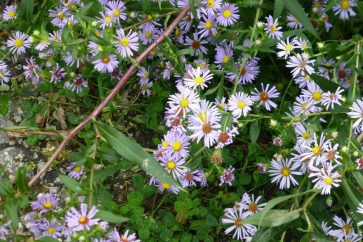

Britton, N.L., and A. Brown. 1913. An illustrated flora of the northern United States, Canada and the British Possessions. 3 vols. Charles Scribner’s Sons, New York. Vol. 3: 419. Provided by Kentucky Native Plant Society. Scanned by Omnitek Inc.
Where Commonly Found: Meadows, fields, shores of lakes and rivers, swamps, CA, MA, ME, NH, NY, RI, VT
How to Identify:
(For unfamiliar words: Wikipedia Glossary of Botanical Terms).
Go Botany Key for Symphyotrichum puniceum.
Missouri Botanical Garden’s description of Symphyotrichum puniceum. Click on more images.
Flower Type: Panicles of violet with yellow center flowerheads located at the top of the central stems with some smaller flowerheads on lateral surfaces. Petal-lie rays are lavender, pale blue-violet or purple, and often white, with 30 – 50 ray florets. Tubular disk florets are 5-lobed, starting yellow and becoming dull red.
Flower Time: August to September
Leaf Arrangement: Alternate leaves on stout stems that are light green to reddish purple, terete to slightly grooved, with stiff spreading hairs. Bases of leaves partially clasp the stem. The lower leaves fall away at flowering time.
Leaf Type: Medium to yellowish green, (sometime purple in the fall), lanceolate leaves, 6″ long by 1 3/4″ wide, smaller long the upper half of the plant, usually glabrous and some hairs along the central veins of the lower sides.
Height: 6′ – 8′
Seed Collection: Seeds are purple to brown dry cypsela, 2.5 – 3.5 mm long with white pappus for wind dispersal.
Attracts: Bees and Butterflies
Use: Naturalizing and Rain Gardens
Light: Full Sun to Part Sun
Hardiness Zone: 2 to 9 USDA Zone Map
Soils: Moist to Wet
Notes: Symphyotrichum puniceum (Swamp Aster) There seems to be an aster for every setting! This aster, with striking purple stems, is particularly useful for wet sunny areas like rain gardens! Noted as deer-resistant by Wild Seed Project.
Native to Northeast, Midwest and Mid-Altantic US: Biota of North America Program (BONAP) – North American Plant Atlas (NAPA).
You must be logged in to post a comment.